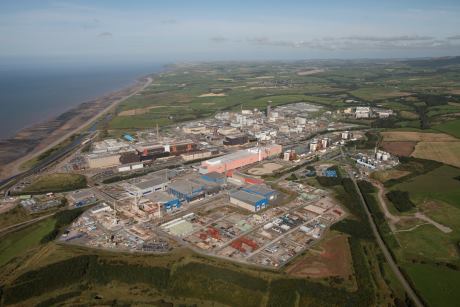A new industrial strategy published by the UK government sets out detailed plans to enable the country to make the most of opportunities for economic growth in the nuclear energy sector at home and abroad.
 |
| Sellafield, focus of much of the UK's decommissioning program (Image: Sellafield Ltd) |
Announced in a joint statement by the UK's business secretary Vince Cable and energy secretary Ed Davey, the 90-page industrial strategy document entitled The UK's Nuclear Future is the latest stage in governmental plans to publish strategies for eleven key sectors. It sets out the government's "clear expectation that nuclear will play a significant role in the UK energy mix in the future" and outlines the government's plans to align the UK as a leading civil nuclear energy nation. It covers the nuclear energy industry in its entirety, encompassing new build, waste management and decommissioning, fuel cycle services, and operations and maintenance.
A key commitment covered by the strategy is £15 million ($23 million) to establish a new National Nuclear Users Facility for universities and companies carrying out nuclear technology research, with centres at the National Nuclear Laboratory (NNL) at Sellafield, the Culham Centre for Fusion Technology and the University of Manchester's Dalton Cumbrian facility. £18 million ($27 million) of support awarded to 35 nuclear research and development (R&D) projects. £12.5 million ($19 million) is committed to the UK's decision to join the Jules Horowitz Test Reactor Program, announced earlier this month. Future reactor designs and their fuel cycles will be kept under review, including consideration of the feasibility of launching a small modular reactor (SMR) R&D program that would enable the UK to be a key partner of any new reactor design for the global market.
The strategy outlines actions needed to attract domestic and inward investment in nuclear projects and to help firms penetrate overseas markets and also to ensure that the UK has the necessary skills for the future.
The document builds on a major review into UK nuclear R&D capability undertaken in response to a House of Lords inquiry into the country's nuclear R&D capacities which has also been published. The raft of documents includes a vision statement setting out the country's nuclear industry ambitions over the next 40 years and a roadmap setting out R&D activities and timelines.
The strategy sees the mission and role of the NNL change to enable it to take on a more central role in advising the government on nuclear issues and strategic research projects. The NNL will also be responsible for hosting the Nuclear Innovation Research Office (NIRO) which will take forward the work of the newly-created Nuclear Innovation Research Advisory Board (NIRAB), which will work to help define a national nuclear energy R&D program.
Vince Cable said that the nuclear industry provided significant opportunities for economic growth, while Ed Davey noted that nuclear and other low-carbon power would be crucial to the UK going forward. "We need all our energy options in play in the fight against climate change, and to keep the lights on in a way that is affordable to consumers. Not just this decade, but to 2050 and beyond," he said.
The strategy has been widely welcomed by spokespeople from the nuclear industry and academic sectors. UK Nuclear Industry Association chairman Lord Hutton applauded the government's "firm commitment" to nuclear's continuing role, while the UK government's chief scientific advisor John Beddington said the announcements on R&D and skills were the first steps to meeting potential future demands that could exceed current new-build plans.
The strategy is published a week after planning consent was granted for Hinkley Point C, the UK's first new nuclear power plant in 25 years. EDF Energy plans to build two Areva EPR reactors at the site, but the company has yet to reach a final investment decision on the project. Discussions are still ongoing between EDF subsidiary Nuclear New Build Generation and the UK government about financial terms for the project. Under the contract for difference (CfD) mechanism, a generator's income would be topped up when market prices for power are below a so-called strike price. Strike prices are to be set for all forms of low-carbon power generation.
Researched and written
by World Nuclear News




_47120.jpg)

_23621.jpg)






